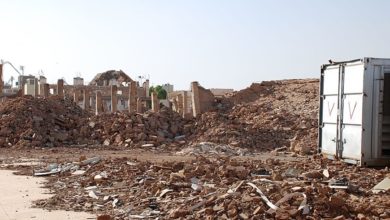The United States has the largest prison population rate in the world today. According to a Dec. 15, 2011 Bureau of Justice Statistics release, more than 2.3 million people are behind bars today, with nearly 4.9 million more on probation or parole.
The number of working class families who do not have someone caught up “in the system” continues to shrink—especially in the African American and other oppressed communities.
The prison boom began in the late 1970s. It parallels the high-tech revolution and the massive restructuring of the U.S. economy and industry over the same time period.
Advances in computerization and science once promised a new era of abundance. But the result was that high technology propelled manufacturing to a new stage where millions of higher-paying jobs—many of them union jobs—were wiped out.
Countless plants were shut down altogether, especially in major urban areas. This had a disproportionate impact on African American workers, as well as those from other oppressed communities. Large sections of cities, big and small, were decimated.
The impact of high-tech machinery, outsourcing and restructuring is well known and documented. What is less understood is the relationship of this fundamental economic shift to the dramatic expansion of prisons in the United States.
At the same time that high tech changed the manufacturing world, the judicial and penal system boomed. The prison population ranged around 200,000 to 215,000 from 1960 through the mid-70s. By the beginning of the 1980s, this number had doubled. It would double yet again by the early 1990s. Today the numbers are staggering.
Why has the prison system exploded?
Why is the prison system growing so fast? Is there so much more crime now? On the contrary—all reports show that crime rates have fallen.
Many studies suggest that recent stricter laws around sentencing, such as the “three strikes” law in California, have greatly contributed to this trend. However, this does not completely explain the steady growth before and after these laws were passed.
Others point to drug abuse. Indeed, huge numbers of poor people are in jails or prisons due to drug-related crimes. Between 1988 and 1994, the number of drug-related incarcerations rose 155.5 percent. African Americans, while having a similar drug use rate as whites, represent 75 percent of those convicted on drug charges.
But to focus on increased drug use is to mistake a symptom for a cause. There were plenty of drugs in the 1960s and 1970s and yet the prison numbers were not what they later became.
The drug crisis and the corresponding “war on drugs” are themselves creations of the very banks and government that benefit most from the mass incarceration of the country’s poor and working people.
Conveniently enough for the capitalist bosses, the drug epidemic allowed them to imprison huge numbers of poor people. Some explain the prison boom by pointing to how mass incarceration provides a way to create a new layer of workers: those who legally work for much less than minimum wage. Prisons are increasingly privatizing their inmates’ labor, employing them as telemarketers, travel agents, furniture makers and much more, usually earning pennies per hour.
However, while these are easy profits, this is again a byproduct, rather than the cause, of the prison increase. The percentage of prisoners working for private corporations remains relatively low.
Prisons as warehouses for the poor
The prison system has been an essential tool for the ruling class to politically manage the high-tech revolution. It has on the one hand organized the newly unemployed workforce, as well as the urban communities where jobs are scarce. On the other hand, it provides a racist tool to terrorize the rest of the workforce against any resistance.
Prisons are the ruling class’ solution to the contradiction of “surplus” workers in the high-tech era and the deepening capitalist economic crisis.
The fundamentally racist core of U.S. capitalism focuses its imprisonment binge on African American and other oppressed workers. This becomes a tool to create a divide between white and other nationally oppressed workers, particularly now that they are working more closely together.
The pretense of “rehabilitation” has been largely dropped from the prison system. In California, this word was simply deleted from the Corrections Department’s mission statement. It is no coincidence that many atrocities committed at Abu Ghraib prison in Iraq were by U.S. soldiers with experience as prison guards.
Prisons are also concentration camps for the poor and the unemployed. By warehousing the poor, the ruling class aims to defuse the potential for mass rebellions if all these unemployed workers were on the streets demanding jobs.
In this sense, the enormous expansion of the prison system is inspired by the memory of the urban rebellions of the 1960s, and the anticipation of revolts to come.
The world’s leading jailer—by far
With over 7.1 million adults on probation, in jail or prison, or on parole, this amounts to 1 in 33 adults. The total population “in the system” has gone up nearly 60 percent in the last twenty years, according to a Bureau of Justice Statistics report.
Compare that to the rest of the world. According to the World Prison Population List, the United States has the highest prison population rate in the world: 754 prisoners per 100,000. It is followed relatively distantly by Russia, Belarus, and the U.S. Virgin Islands. The average worldwide rate is 80 per 100,000. The United States has less than 5 percent of the world’s population but 23 percent of its prison population.
Not surprisingly, the amount of money spent in jails and prisons has jumped from $9 billion in 1982 to a whopping $60 billion in 2009. The huge increases in police spending have mirrored this trend.
While more people are going to jail or prison and are unable to work, much more money is being spent on the state apparatus. This increase in spending has come at the expense of social programs like housing and education.
An assault on Black America
The impact of the misnamed “corrections” system on the African American community in particular is devastating. Black males make up 35.4 percent of the jail and prison population even though they make up less than 10 percent of the overall U.S. population.
The rate of incarceration for Black men is six times higher than their white counterparts. African American women do not fare much better and are four times more likely to enter the prison system than white women. (That number has gone down in the last ten years because of the 50 percent increase in the incarceration rate for white women.)
Further, African Americans in prison are not counted as part of the unemployed, covering the real unemployment figures which could be much higher than the current official count of 13.6 percent in the African American community.
Additionally, millions of African Americans have been disenfranchised by being denied the right to vote as a result of their convictions.
To add insult to injury, the U.S. government cynically places prisons outside of the cities that most African American prisoners come from and places them in largely rural, white and more conservative areas. Because prisoners are counted as residents of the district where they are incarcerated but where they cannot vote, these areas gain in legislative representation and receive more government funds, to the detriment of the inmates’ home districts, which are largely urban, African American and poor.
Duke University researcher Taren Stinebrickner-Kauffman noted that this is only a new version of the old “three-fifths compromise” where slaves counted as three-fifths of a person. “The presence of disenfranchised Blacks in the South increased the representation of white Southerners in the House,” she notes.
Conditions for struggle
The economic retooling due to the high-tech revolution, while producing fantastic profits for the ruling class, is also generating tremendous potential for class struggle. Millions of workers find their livelihoods decimated. New sectors of super-exploited workers—Blacks, Latinos, and women—are entering the workforce with experience in the struggle for their rights. It is no surprise that the fastest growing sector of unionized workers is the service sector.
But in the end, just like the socialization of production during capitalist development leads to working class unity and organization, the mass concentration in confinement of the most oppressed will lead to unity of purpose, tactics and training behind prison walls. The Attica rebellion showed the possibilities of what unity and organization can achieve. Malcolm X became a revolutionary in prison. Mumia Abu-Jamal works every day to bring revolutionary consciousness to all our brothers and sisters behind bars.
There are few crimes more glaring than what is being perpetrated against our class by the bosses and their penal system. The working-class demands of solidarity and unity should extend to our whole class, inside and outside of the system.






